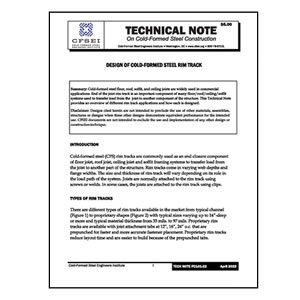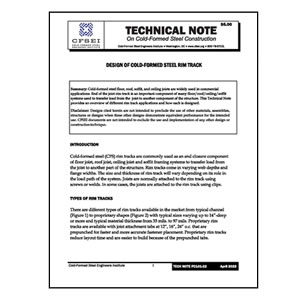Tech Note G801-13: ASTM A1003 – No Cause for Rejection
$5.00
Summary: Building codes and design standards that reference ASTM International (ASTM) A1003 standard for cold-formed steel framing products have the potential to cause confusion and project delays for those who are unfamiliar with the requirements of this new material standard. This Technical Note, first published in 2008, provides a comparison of the requirements of A1003 with the more familiar standards traditionally used for cold-formed steel framing products, and demonstrates that steel ordered or furnished to the old standards should be no cause for rejection. The 2013 revision references a change to the requirements of ASTM A1003 regarding material thickness when ordering or supplying steel sheet.
Disclaimer: Designs cited herein are not intended to preclude the use of other materials, assemblies, structures or designs when these other designs demonstrate equivalent performance for the intended use. CFSEI documents are not intended to exclude the use and implementation of any other design or construction technique.
Related Products

Tech Note B001-20: How Cold-Formed Steel Framing is Produced
Summary: Cold-formed steel seems like a fairly simple product when you are holding it in your hand, but as you can see, there are many production steps involving things like mining iron ore out of the ground, creating molten steel, furnaces above 2,000°F, reduction mills imparting forces in excess of 100,000 pounds per square inch, and hydrochloric acid cleaning baths before it even reaches the roll forming stage. This Tech Note has provided a basic outline of the processes involved in producing the products you work with daily, be it manufacturing, drafting, designing, engineering, installing or demolishing a building at the end of its life cycle.
Disclaimer: Designs cited herein are not intended to preclude the use of other materials, assemblies, structures or designs when these other designs demonstrate equivalent performance for the intended use. CFSEI documents are not intended to exclude the use and implementation of any other design or construction technique.

Tech Note G105-22: Compression Member Reinforcement
Summary: To modify the capacity of a compression member, e.g. wall stud or truss web, adding a reinforcement may result in a non-prismatic member. This Tech Note provides guidance to evaluate the strength of a non-prismatic compression member.
Disclaimer: Designs cited herein are not intended to preclude the use of other materials, assemblies, structures or designs when these other designs demonstrate equivalent performance for the intended use. CFSEI documents are not intended to exclude the use and implementation of any other design or construction technique.

Tech Note B006-20: Introduction to Evaluation Services and Explanation of Evaluation Reports
Summary: Evaluation reports act as a bridge between authorities having jurisdiction (AHJs) and manufacturers in conveying specific information on building products and systems relative to compliance to codes and standards. When an evaluation report is made available and determined as supporting the product’s use in projects, approval of the code official should be solicited. After such approval is attained, the design and installation details given in the report need to be observed and the labeling of the actual product needs to match the description provided in the evaluation report.
Disclaimer: Designs cited herein are not intended to preclude the use of other materials, assemblies, structures or designs when these other designs demonstrate equivalent performance for the intended use. CFSEI documents are not intended to exclude the use and implementation of any other design or construction technique.

Tech Note B005-20: Introduction to Cold-Formed Steel Framing Design Aids
Summary: Both steel industry and manufacturers’ associations provide design aids that assist engineers with the proper application of the cold-formed steel design challenges. Design examples and design aids are essential to educate an engineer in the proper use and design of cold-formed steel members, connections and assemblies. This Tech Note provides an overview of some of the available cold-formed steel framing design aids.
Disclaimer: Designs cited herein are not intended to preclude the use of other materials, assemblies, structures or designs when these other designs demonstrate equivalent performance for the intended use. CFSEI documents are not intended to exclude the use and implementation of any other design or construction technique.

Tech Note S200-20: Design of Cold-Formed Steel Systems for Raised Platforms, Stages and Theater Seating
Summary: It is common for cold-formed steel (CFS) to be used in the construction of raised platforms, stages, and theater seating. It is the intent of the Technical Note to provide an overview of considerations to address when designing such framing, along with some design examples.
Disclaimer: Designs cited herein are not intended to preclude the use of other materials, assemblies, structures or designs when these other designs demonstrate equivalent performance for the intended use. CFSEI documents are not intended to exclude the use and implementation of any other design or construction technique.

Tech Note L200-09: Roof Framing Anchorage Forces: MWFRS or C&C
Summary: This Technical Note defines the two levels of force and discusses the effects of using Component and Cladding (C&C) loads versus Main Wind Force Resisting System (MWFRS) calculated uplift loads. Design examples are provided to indicate the difference in roof-to-wall anchorage force for either type of load. Mainstream reference standards and quotes from field experts are cited when discussing the appropriate levels for calculating the uplift forces.
Disclaimer: Designs cited herein are not intended to preclude the use of other materials, assemblies, structures or designs when these other designs demonstrate equivalent performance for the intended use. CFSEI documents are not intended to exclude the use and implementation of any other design or construction technique.

Tech Note W600-21: Cold-Formed Steel Load-Bearing Wall Design
Summary: This Technical Note has been written to help cold-formed steel (CFS) engineers further their understanding of structural load-bearing CFS walls. Given the myriad of details required for such structures, the importance of proper design and analysis of load-bearing CFS members cannot be understated. This Technical Note will discuss the various design considerations that must be taken into consideration during the design phase of such structures.
Disclaimer: Designs cited herein are not intended to preclude the use of other materials, assemblies, structures or designs when these other designs demonstrate equivalent performance for the intended use. CFSEI documents are not intended to exclude the use and implementation of any other design or construction technique.

Tech Note B002-20: How Cold-Formed Steel is Used in Building Construction
Summary: Cold-formed steel framing is used in numerous applications across the building industry. The purpose of this Technical Note is to provide a general overview of common cold-formed steel shapes and various applications in which they are used.
Disclaimer: Designs cited herein are not intended to preclude the use of other materials, assemblies, structures or designs when these other designs demonstrate equivalent performance for the intended use. CFSEI documents are not intended to exclude the use and implementation of any other design or construction technique.

